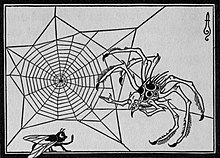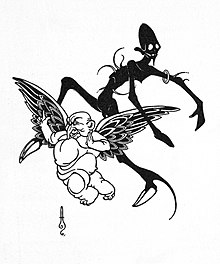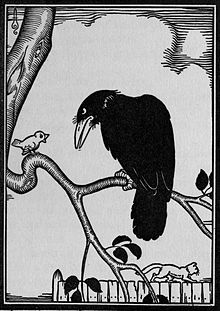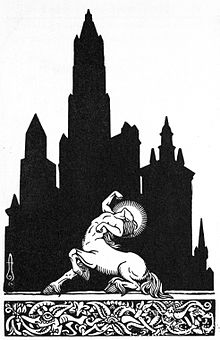Boris Artzybasheff
Boris Artzybasheff ( Russian Борис Михайлович Арцыбашев , Boris Michailowitsch Arzibaschew ; born May 25, 1899 in Charkow , Russian Empire , today's Ukraine ; † July 16, 1965 ) was an American illustrator of Russian origin. He was known for his detailed, precise style with often surrealistic content.
Life
Artzybasheff was born the son of the Russian writer Mikhail Arzybaschew in Kharkov in what is now Ukraine . In 1919 he emigrated to the United States and initially worked in an engraving company. This activity certainly contributed to the precision of his own works. There are no traces of the design in Artzybasheff's pictures. All the lines are clear and perfect. His first publication as an illustrator appeared in 1922. Over the years he has illustrated over 50 books, including with his own text. He became best known for his pictures in magazines, especially his over 200 covers in TIME magazine . After 1940 he also increasingly designed commercial advertisements.
His artistic subjects are very diverse. First he illustrated fairy tales and fables with imaginative pictures. These works are preferably stylized in black and white woodcut style with echoes of the Art Nouveau and Art Deco epochs. Other works are political, particularly satires against German fascism and the Soviet regime. He was unique in one field: the fusion of technical objects with organic forms. This anthropomorphism is also evident in his pictorial representations of psychic phenomena.
His estate is administered by Syracuse University .
Styles
Artzybasheff has divided his compilation " As I See " into four chapters, which correspond to his different intentions:
- Neurotica : Surrealistic visions that address human moods. Comparable to works by Salvador Dalí and Max Ernst .
- Machinalia : anthropomorphisms ; At first glance exact images of machines that, on closer inspection, contain human traits. Comparable to the masters of Mannerism like Giuseppe Arcimboldo and Giovanni Battista Piranesi .
- Diablerie : depictions of violence in dictatorship and war. Comparable to John Heartfield and George Grosz .
- Escapades : Free storytelling about human pitfalls and passions. Comparable to the old masters Hieronymus Bosch and Pieter Brueghel the Elder .
Awards
- 1928 Newbery Medal for the book Gay-Neck by Dhan Gopal Mukerji.
- 1938 Caldecott Medal Honor for his book Seven Simeons .
Illustrations (selection)
- 1922 Dmitry Mamin-Sibiryak ( EP Dutton ): Verotchka's Tales
- 1922 John Peale Bishop and Edmund Wilson : The Undertaker's Garland , published by AA Knopf
- 1924 Harriet Martineau : Feats on the Fiord (Macmillan Children's Classics)
- 1927 Ella Young : The Wonder Smith and His Son
- 1927 Dhan Gopal Mukerji : Gay-Neck, the Story of a Pigeon
- 1927 Padraic Colum : Creatures
- 1930 Padraic Colum : Orpheus: myths of the world
- 1934 Youel B. Mirza : Son of the Sword
- 1935 Lewis Browne : All Things Are Possible, an apocryphal novel (dust jacket)
- 1935 Charles G. Finney : The Circus of Dr. Lao
- 1937 Boris Artzybasheff: Seven Simeons (Russian fairy tale)
- 1939 Honoré de Balzac : Droll stories; Thirty tales , translated by Jacques Le Clercq. Publisher: The Heritage Press
- 1940 Anne Gertrude Hall : Nansen (biography)
- 1942 Ruth Smith : The Tree of Life: selections from the literature of the world's religions
- 1949 Raymond Chandler : The Little Sister (dust jacket)
- 1950 Raymond Chandler : The Simple Art of Murder (dust jacket)
- 1954 Boris Artzybasheff: As I See. Notes to Folios by the Artist . Publisher Dodd, Mead and Company. (A collection of images spanning many years, reprinted by Titan Books, London 2008. ISBN 9781845767679 )
Web links
- American Art Archives (illustration, advertising)
- jalopyjournal (machines)
- Flickr album
- modern mechanix
- darkroasted blend
- Syracuse University Boris Artzybasheff papers
- Society of Illustrators Hall of fame
- Jim Vadeboncoeur JVC Publishing book launch
- artcyclopedia Collection of cover pictures from TIME magazine .
- Neurotica
- Machinalia
- Gallery of promotional designs
- University of North Texas Gallery of Posters
Individual evidence
- ↑ From 1941 to 1965 the TIME magazine published over 200 of its cover illustrations: time.com ( page no longer available , search in web archives ) Info: The link was automatically marked as defective. Please check the link according to the instructions and then remove this notice.
- ↑ Anthropomorphic are also changes in contemporary portraits caused by objects from their lifeworld, e.g. For example, Richard Buckmister Fuller is merged with one of his geodesic domes on the TIME cover picture. This motif also appears on a postage stamp and was finally processed into an animation: Buckminster Fuller gives an opinion on the Lord's Prayer .
| personal data | |
|---|---|
| SURNAME | Artzybasheff, Boris |
| ALTERNATIVE NAMES | Arzibaschew, Boris Michailowitsch |
| BRIEF DESCRIPTION | American illustrator |
| DATE OF BIRTH | May 25, 1899 |
| PLACE OF BIRTH | Kharkov |
| DATE OF DEATH | July 16, 1965 |
| Place of death | New York City |




